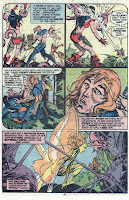Book Review: 'A Spaceship for the King' by Jerry Pournelle
4 / 5 Stars
‘A Spaceship for the King’ first was serialized in Analog in the Winter of 1971 - 1972. A revised version was published by DAW, as Book No. 42 (157 pp.), in February 1973. The cover artwork is by Kelly Freas.
Subsequent printings of the novel by Orbit, Simon and Schuster, Pocket Books, and Baen, used the title 'King David's Spaceship'.
After engaging in internecine warfare for centuries, the Galactic Empire emerges victorious but badly depleted. Re-establishing its hegemony over the various colony worlds scattered around the galaxy will have to be done on the cheap. Accordingly, individual destroyers are sent out to convince those planets unenthused about re-joining the Empire…. and paying taxes…of the error of their ways. Only those planets with starflight capability are immune from coercion, as the Empire has no desire to battle any forces with a technological capacity equal to its own.
On Prince Samual’s World, the arrival of an Imperial destroyer causes consternation. For centuries the citizens of Samual’s World, where the technology is at a level similar to that of Central Europe ca.1950, have occupied themselves with various Ruritanian wars and intrigues. At first they resist the Imperial force, but after several of their cities and armies are burned to cinders by the orbiting destroyer, they have no choice but to submit to the Empire.
King David the Ninth, the ruler of Samual’s World, is ill disposed to seeing his planet become a vassal to the distant Empire. There is one loophole that he can exploit: any planet possessing spaceflight is granted a measure of independence from Imperial rule. But how can Samual’s World build a functioning starship when the Empire carefully restricts access to advanced technology ?
The answer: on the planet Makassar, now descended into barbarity and anarchy, stands a Temple with a library filled with data records from Old Earth – including records on how to construct a starship.
Former colonel Nathan MacKinnie finds himself the lead agent on a desperate mission for King David: under the guise of a Trader, MacKinnie is to board an Imperial Trading Association starship heading to Makassar. Once on Makassar, MacKinnie is to locate the Temple and gain the library records that will lead to freedom for Prince Samual’s World.
But the mission will not be easy. The Empire has no interest in sending an escort to protect a group of traders and merchants on a backwater planet like Makassar. It will fall to MacKinnie to make his own way through pirate fleets and barbarian hordes to the Temple…and once there, he has to convince the ruling aristocracy to let him have access to the sacred records no off-worlder is allowed to see….
‘A Spaceship for the King’ is a well-written, solid SF adventure with a military bent. Author Pournelle has tended to be overlooked by the SF establishment at large, primarily because of his libertarian / conservative political attitudes and the decidedly commercial nature of much of his fiction (Pournelle, along with longtime co-author Larry Niven, never embraced the New Wave ethos or its creed of Art before Commerce).
There are passages of ‘Spaceship’ that get a little too self-indulgent; a description of a sea engagement comes across as an excerpt from a Patrick O’Brian ‘Aubrey’ novel, and a chapter dealing with a ground engagement goes a bit too deeply into the tactical aspects of sword and shield warfare.
Overall, however, ‘Spaceship’ is one of the better of the early releases by DAW Books, and is worth searching out.
















































































